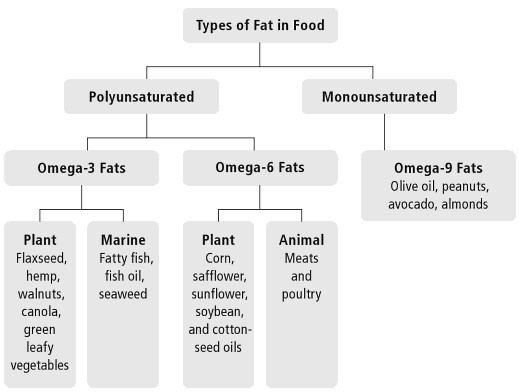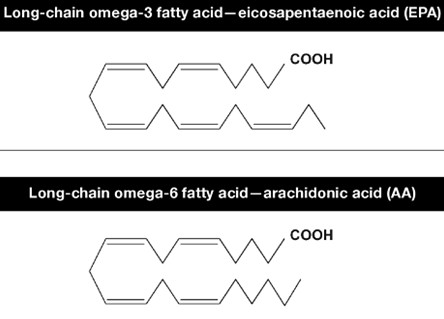Fats that control our Health
Backbone of all Fats
Three billion years ago, the only living things on the planet were algae, which consisted of a single membrane composed primarily of fat. But the membranes formed by algae-derived fats far from static; they dance a rhythm controlled by the fluidity within the fat molecule itself. That fluidity is governed by the number of double bonds in the fat molecule.
Double bonds in fats result when hydrogen atoms have been extracted from the carbon-to-carbon bonds that are the backbone of all fats. This extraction is done in a very specific way to enzymes so that each double (called a cis double bond) forms a kink in the molecular structure of the fat as shown below

The more unsaturated a fat molecule is, the more double bonds it has, and the more fluidity it imparts to the membrane. This fluidity is the key to understanding why algae-derived fats made us smart.
About 550 million years ago, when there was an explosion in biological diversity as multicell organisms were starting to evolve from single-cell algae. These new organisms had to develop a communication system so their specialized cells. Another involved the use of hormones.
THE STRUCTURE OF FATS
Depending on the function of a particular cell, your body needs specific types of fats to keep the cell membranes in their appropriate fluidity zone. For example the cells that surround the nerves in your brain need to be very rigid because they provide insulation to maintain the fidelity of the electronic signals. On the other hand, the cells in the retina of the eye have to be extremely fluid to allow visible information to pass into the brain.
Fats can be categorized by their fluidity; they are either
* saturated (solid at room temperature),
* monounsaturated (liquid at room temperature, but cloudy in a refrigerator), or
* Polyunsaturated (liquid in a refrigerator).
Type of Unsaturated Fats in Food

The number of double bonds contained within the fatty acid determines these designations. The more double bonds the fat has, the more fluid (unsaturated) it is. However, the more unsaturated a fat is the more prone it is to be attacked by free radicals, which causes rancidity. Since fish oils contain high levels of polyunsaturated fats, they are quite likely to become rancid.
The first hormones developed by living organisms were known as eicosanoids, and they used fats in cell membranes as their building blocks. These eicosanoids don’t use just any type of fat for their synthesis; they require the long chain highly unsaturated (polyunsaturated) fat found only in algae-derived fats. These were the same fats that made us smart 150,000 years ago, and the eicosanoids that are derived from those fats control out health today.
Do you ever wonder why fish gets a fishy smell after a day or two in your refrigerator? That’s due to its high polyunsaturated fats, which are becoming oxidized.
Within the classification of polyunsaturated fats, there is one further subdivision: omega-3 and omega-6 fats. This distinction has to do with the position of the double bonds in the fat, which determines its three-dimensional structure. This ultimately determines the type of eicosanoids that can be made from fats.
Furthermore, the length of the polyunsaturated fatty acid is critically important, because only the longer chain polyunsaturated fatty acids (20carbon atoms) have the number of double bonds that can provide the fluidity necessary for cells in the retina to transmit visual images to the brain, for never synapses to transfer information throughout the brain, and for the brain’s mitochondria to produce optimal amounts of energy.
In addition, only the long chain polyunsaturated fats (both omega-6 and omega-3) can be used in the manufacture of eicosanoids, which are the keys that ultimately control human health.
Molecular structure of long-chain omega-3 and omega-6

Fats can be synthesised either “good” or “bad” eicosanoids. Long-chain omega-3 fatty acids (found in fish oil) are the building blocks necessary to help manufacture “good” eicosanoids. On the flip side , long-chain omega-6 fatty acids (found in high concentration in vegetable oils) are the building blocks used to manufacture “bad” eicosanoids. The balance of “good” and “bad” eicosanoids will be the primary factor determining your physical and mental health.
Fish oils are rich in long-chain omega-3 fats. Long chain omega-3 fats called eicosapentaenoic acid (EPA) is the key fat for health, whereas docosahexaenoic acid (DHA) is the key fat for the brain. Fish oil is rich in both.
